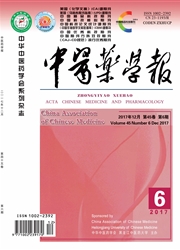

 中文摘要:
中文摘要:
目的:从血小板角度分析血瘀形成的机制。方法:20只大鼠,按体质量随机分成空白组和寒凝血瘀组,寒凝血瘀组按照冰水浴加注射肾上腺素的方法连续造模15 d。禁食不禁水12 h后,第16天以乌拉坦1 mg/kg麻醉,固定,颈总动脉取血,测与血小板相关的各项指标。结果:与空白组比较,寒凝血瘀组血浆黏度、PDW极显著升高(P〈0.01);PLT极显著降低(P〈0.01);TXB2、β-TG、FN显著增高(P〈0.05);6-keto-PGF1α、CAMP、CGMP均有降低趋势,但是无显著影响;VWF、PF4、MPV有升高趋势,无统计学意义。结论:寒凝血瘀形成机制可能是通过影响TXB2,FN,β-TG来促进血小板黏附、聚集作用,进而导致血瘀的形成。
 英文摘要:
英文摘要:
Objective: To investigate the biological difference in platelet rats with blood stasis by cold stagnation. Methods:Twenty Wistar rats were randomly assigned to a blank control group and a cold stagnation and blood stasis group. The blood stasis group was in accordance with the method of ice water bath and injection of epinephrine building for 15 days in a row. Platelet indexes were determined after 15 days. Results: Compared with the blank control group,plasma viscosity and PDW in model group were increased significantly. PLT was decreased significantly. The contents of TXB2,FN and β-TG were increased significantly( P〈0. 05). There was no significant difference in the contents of 6-keto-PGF1α,VWF,MPV,etc. Conclusion: Haemorrheological nature formation mechanism of blood stasis may be by influencing the TXB2,FN,β-TG to promote platelet adhesion and aggregation,leading to the formation of blood stasis.
 同期刊论文项目
同期刊论文项目
 同项目期刊论文
同项目期刊论文
 期刊信息
期刊信息
